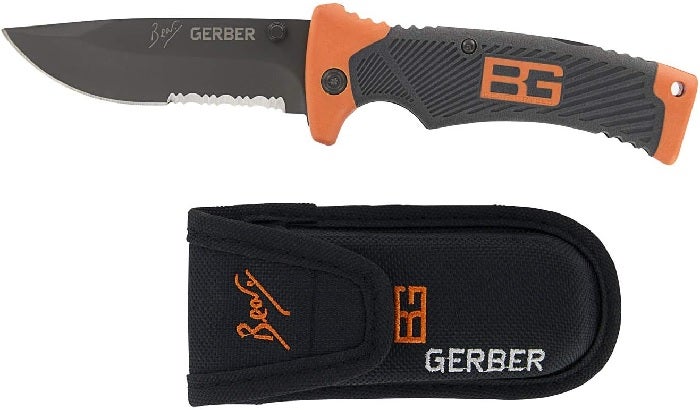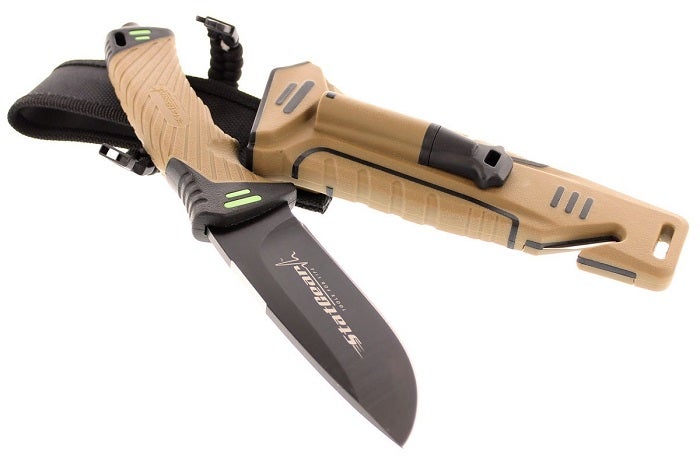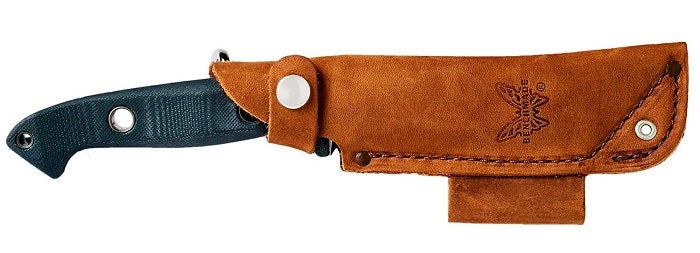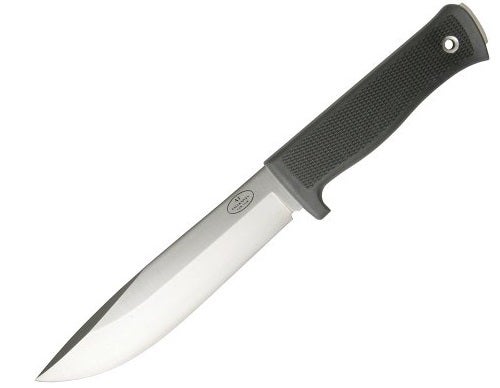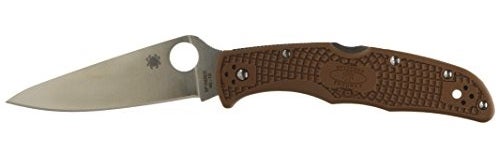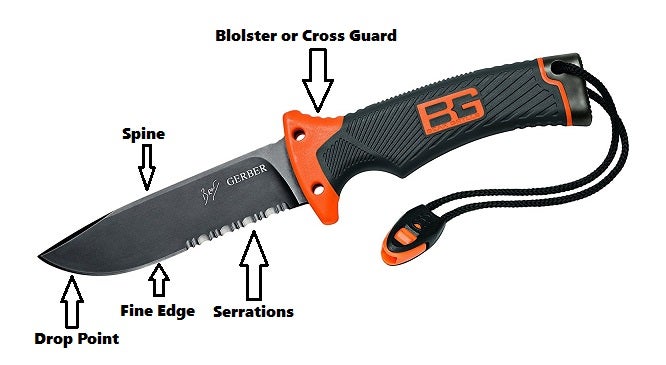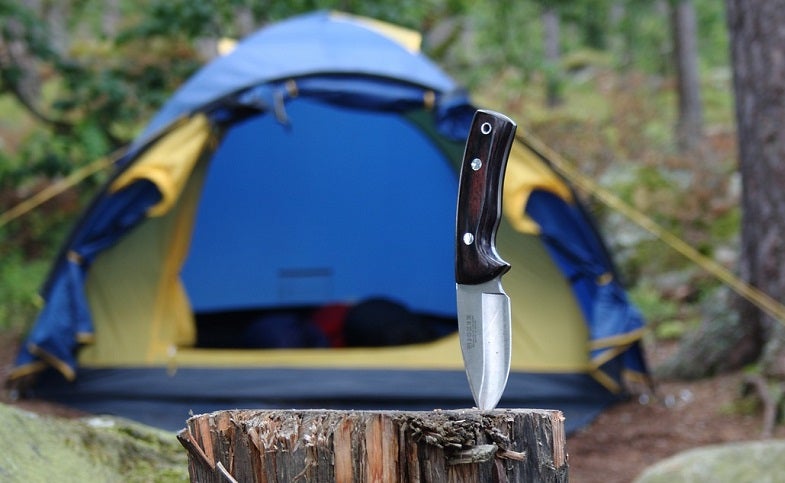
Our Editors independently research, test, and rate what we feel are the best products. We use affiliate links and may receive a small commission on purchases.
Like any young boy growing up in the countryside of America, I was always fascinated with knives. I grew up hunting, fishing, and being in the woods.
Knives were second nature to me from a very young age and I learned to use them, throw them, make them, and sharpen them. Rarely was I without one of my favorite camping knives on trips with my grandfather.
As I grew up to become an outdoor guide and of late, a blacksmith, the role of knives in my life evolved through many stages. Today I carry one on a lanyard attached to my hiking backpack.
When you’re looking for the best camping knife you’ll find no end of varieties and marketing language. Once you understand how they’re made, which features make sense, and how to “cut” through the hype and find a truly great knife you’ll have a keeper. Let’s dig in!
Best Camping Knives
For more of my camping gear recommendations, have a look through these popular Outside Pursuits guide links: Backpacking Water Filter, Backpacking Fire Starter, GPS Hiking Watch.
So what is the best knife for camping and hiking?
Quick Answer: The 7 Best Rated Camping & Hiking Knives
- Gerber Bear Grylls Ultimate Knife
- StatGear Surviv-All Outdoor Knife
- Victorinox Swiss Army Pocket Knife
- Benchmade Bushcrafter 162 Knife
- Fallkniven A1 Survival Fixed Blade Knife
- Spyderco Endura4 Lightweight FRN
- Buck 192BR Vanguard
Now I’m going to help you decide on a top rated camping knife, then we’ll talk about how to choose the right one for you in our buying guide below.
Camping Knife Reviews
#1 Gerber Bear Grylls Folding Knife
- Blade Material: High Carbon Stainless Steel
- Blade Design: Folding, Drop point
- Serrated: Yes (fine edge available)
- Sheath: Yes
- Weight: 4.3 oz
This one earns top marks for blade design, handle design, and color. It’s a camping knife made with a beefy drop point profile, nearly full-bevel, and deeply inset finger relief.
On top of that, they put a nice ergonomic bolster on it to separate the handle from the blade. Just in case your hands are wet and you stab the knife into something, you don’t want your hand sliding down the blade!
The knife is made by Gerber, one of my all-time favorite knife makers, and sponsored by Bear Grylls, one of my all-time least favorite “survival” gurus.
If you don’t like the half-serrated knife blade, which renders half the blade useless for most tasks, it is also available in a non-serrated “Fine-Edge” model as well. I like the orange accent color – easy to spot if you drop it or set it down in the leaves.
It comes with a small knife sharpener but they sell a better one here. Overall the Gerber Bear Grylls knife is my top pick for the best camping knife.
#2 StatGear 99416 Surviv-All Outdoor Knife
- Blade Material: 440 Stainless Steel
- Blade Design: Fixed, Drop point
- Serrated: No
- Sheath:: Yes
- Weight: 14.7 oz
Now we’re really thinking! The StatGear knife is a 440-stainless steel drop point blade that’s beefy and lacks any serrations! The synthetic handle is rugged, features finger relief, and a wide bolster.
They put a ferro rod in the sheath like the Gerber Bear Grylls knife, but instead of serrations they opted for a webbing cutter on the sheath!
Overall I really think they put together the most critical design features of a good survival knife. They even made the smart move to put a few brightly colored yellow-green strips on it for visibility.
No survival knife is useful if you set it down and can’t see it amongst the leaves! They also put a sharpening stone in the knife sheath so that in a worst-case scenario, you’ll be able to rudimentarily hone the blade.
Overall I think this survival knife brings together everything we need in knife and nothing we don’t. My biggest complaint is that the sheath is ugly as sin, but I’ll give it a pass on that since they did forgo the serrations!
With a built in fire starter and knife sharpener, the StatGear would be my top pick for the best fixed blade camping knife.
#3 Victorinox Swiss Army Pocket Knife
There are a few Swiss Army Knife tools that I find to be universally useful for woodscraft. The magically sharp and hyper effective folding pocket saw always seems to work better than it has any right to. The included scissors are always on-point and ready to do work. Also, the Swiss Army pocket knives always seem to be nicely sharpened and ready to go. If you want to take the kitchen sink with you when you go hiking and backpacking, this knife will be ready to help you set it up. It’s got over 30 different functions from screwdrivers to cork screws. I will mention that I find many of the features on the full-size Swiss Army Knife don’t get used very often. That’s why I use the Classic SD version for most of hiking needs. While it’s not going to win awards for innovation in blade design or knife quality, the Victorinox Swiss Army knife is a classic and my pick for the best hiking knife. There’s something to be said about having the right tool for the job when you need it!
#4 Benchmade Bushcrafter 162 Knife
- Blade Material: CPM-S30V Stainless Steel
- Blade Design: Fixed, Drop point
- Serrated: No
- Sheath: Yes
- Weight: 7.7 oz
Benchmade has a reputation for making high quality knives at an affordable price. By all accounts, they’re about as close to a top-tier handmade knife as you can get without paying through your nose.
That said, however, they will cost you a pretty penny more than your standard off-the-shelf knife. Why? Because they take the quality and craftsmanship up a level.
Benchmade produced this fine-edge knife with a nice wide bevel and gentle taper. The perfect design for a great utility knife for camping.
On top of that they kept the handle simple with a 3-rivet micarta handle that features generous finger relief to prevent any slipping. There’s even a lanyard hole at the end, just waiting to accept your favorite paracord color.
I love the full tang construction and nearly indestructible micarta handle. I think the sheath leaves something to be desired, but I’ll accept that considering that the knife is high quality.
While it’s probably the best knife for camping, the higher cost may put some people off.
#5 Fallkniven A1 Survival Knife Fixed Blade
- Blade Material: Vg10 Stainless Steel
- Blade Design: Fixed, Drop point
- Serrated: No
- Sheath: Yes
- Weight: 14.4 oz
Another name in the high quality, budget priced knife arena contributes this very similar drop point camping knife.
A generous blade length, substantial finger relief and bolster, and full tang construction make it rugged and beefy. You’ll be hard pressed to find something about this knife that you don’t enjoy.
It is a modern looking knife, although it’s austere and plain. If you’re looking for the classical wood and leather feel, however, this isn’t going to be for you.
Getting the job done with modern materials, machining, and quality is the name of the game here.
I do like that the tang extends beyond the end of the handle. This is a desirable characteristic for those who might consider throwing their knives or using it to hammer in tent stakes.
Note, however, that I do NOT recommend throwing this knife. Use a cheaper and more disposable knife to throw! A good candidate for the best backpacking knife, but also comes at a higher price.
#6 Spyderco Endura4 Lightweight FRN
- Blade Material: Stainless Steel
- Blade Design:Folding blade
- Serrated: No
- Sheath: No
- Weight: 4.8 oz
Spyderco is yet another name in the realm of high quality affordable knives. This pocket folder comes with a pocket clip, low profile, and fine-edge blade lacking serrations.
I applaud the lack of serration particularly on this shorter length blade because it would crowd the already short blade length.
While the handle is slim and features minimal bolster or finger relief, it has a decent texture to provide grip. It can be hard to make a folder with great ergonomics so we won’t dock them too many points for this.
Besides, the overall shape and design of this knife lend it more toward slicing and peeling then any kind of stabbing.
I would wholly recommend this knife as a camping supplement though I worry that it lacks the features many will require for a utility camping knife.
The folding design also makes it more likely to damage when using for heavy duty tasks like splitting. As my primary knife I want a fixed blade but this would be my choice for the best folding knife for camping.
#7 Buck Knives 192BR Vanguard
- Blade Material: 420HC Stainless Steel
- Blade Design: Fixed, Drop point
- Serrated: No
- Sheath: Yes
- Weight: 8 oz
This is the only knife in our lineup that is a clear holdover to the times of old. With a lacquered wooden handle and a wide bolster, polished steel blade and handle fixings, it’s a beauty.
The plain leather sheath is unassuming but fitting. Overall this knife knows its home is in the woods, and that’s where it wants to be.
Without a doubt, it fills all the needs of a fixed blade camping knife that we’ve been looking for. With a deeply recurved tip it also would make a decent little skinning knife.
Some of the other knives on our list, I think, might be a little more robust. However, none of them feature the soul of a woodsman the way that this knife captures it.
I know this is the knife I would have found in my grandfather’s tool box. He always kept something like this close at hand and sharper than a razor and makes a good camping knife.
Best Camping Knives Comparison Table
| Best Camping Knives | Blade Material | Blade Design | Serrated | Sheath | Weight | |
|---|---|---|---|---|---|---|
| Gerber Bear Grylls Ultimate Knife | High Carbon Stainless Steel | Folding, Drop point | Yes | Yes | 4.3 oz | |
| StatGear Surviv-All Outdoor Knife | 440 Stainless Steel | Fixed, Drop point | No | Yes | 14.7 oz | |
| Victorinox Swiss Army Pocket Knife | High Carbon Stainless Steel | Folding, Drop point | No | No | 6.5 oz | |
| Benchmade Bushcrafter 162 Knife | CPM-S30V Stainless Steel | Fixed, Drop point | No | Yes | 7.7 oz | |
| Fallkniven A1 Survival Knife | Vg10 Stainless Steel | Fixed, Drop point | No | Yes | 14.4 oz | |
| Spyderco Endura4 Lightweight FRN | Stainless Steel | Folding blade | No | No | 4.8 oz | |
| Buck 192BR Vanguard | 420HC Stainless Steel | Fixed, Drop point | No | Yes | 8 oz |
How to Choose the Best Knife for Camping
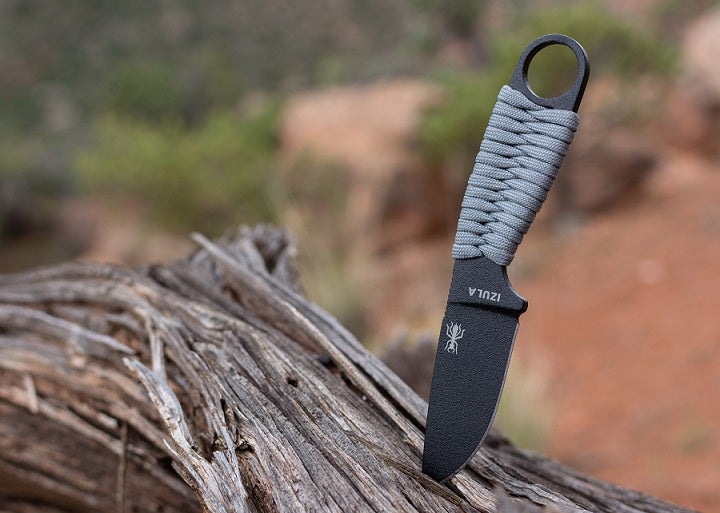
Somewhere in all the rush to make and sell great camping knives to unassuming buyers, most companies have surrounded their camping knives in complicated lingo.
Things like “ultra-high carbon” and “freeze tempered” are all too common buzz words that get knife enthusiasts drooling. Unfortunately, they don’t mean anything and simply act as a disservice to confused buyers. Let’s find out what you really need to know.
Materials
One of the first things that will attract the attention of new knife enthusiasts is the type of steel the knife is made from.
When we see the words “high carbon” it’s often taken as a positive indicator, since high carbon steel is well known to be “good knife steel”. Truth be known, everything from stainless steel to cast iron is technically a “high carbon” steel.
My advice to new knife hobbyists? Unless you’re paying top dollar for your knife, don’t get hung up on the steel type. The vast majority of knife blade materials will hold up just fine as long as you use your knife responsibly and for the proper tasks.
Many knife manufacturers simply state “high carbon” which doesn’t tell us anything meaningful anyways.
Anatomy of a Knife
Blade Design
Few people pay attention to blade design as a fundamental factor in knife buying. This is a big mistake! Why? Because the size, shape, bevel, taper, and overall design of a blade massively impact its overall characteristics and performance.
Since we’re talking about camping knives, I’ll recommend the modest drop point design. This is a classically adopted American utility knife profile with a thick, beefy blade that tapers very little along its length.
I’ll even recommend a full bevel, where the knife is ground from blade to spine in a single continuous slant. Why?
Because these characteristics are rugged, universal, and the full bevel strikes me as perhaps the best overall design for splitting wood (in the same manner as a froe).
Handle Design
For most knives, I advocate a wide and obtrusive bolster (the “cross guard” area). Why? To prevent hands from slipping off the handle and down the blade. On top of this, I also like to see inset finger relief along the handle for the same reasons – improved grip.
Is this necessary on all knives? No. Some combination of the two design features, however, strikes me as prudent for most camping knives.
Serrations
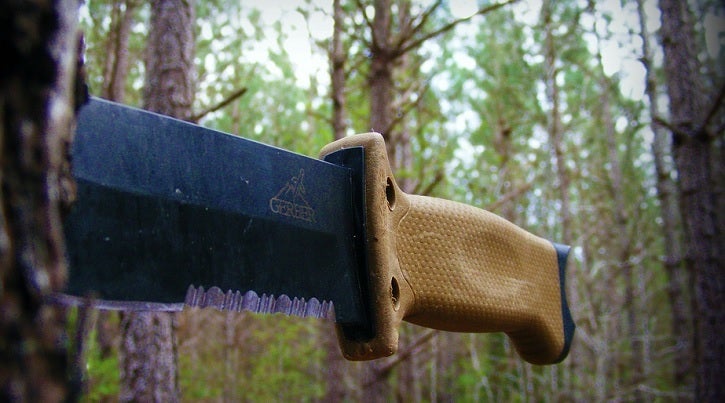
Time and again I weep for a beautifully executed knife that is ruined by serrations. They’re one of the most popular, and most useless, additions to modern blades and I’d love to see them removed from the majority of knives.
Common reasons for serrations include: cutting rope, cutting bone, “sawing” wood, cutting seat belts, etc. I stand before you today as an example of a human capable of doing all of these things with a non-serrated knife. Please, don’t fall over in astonishment.
Best I can tell, serrations have become wildly popular in today’s ever expanding hype of tactical everything. Tactical paracord bracelets, tactical bb-guns, tactical knives. For military service people, sure, I will concede that there is a real need for serrations.
In camping situations, the need for a longer fine-edge blade are far more common. Things like skinning animals, woodworking, and blade control are far more effective without a serrated segment of your knife getting in the way.
Handle Material
We won’t delve too deep here, but suffice it to say that camping and backpacking knives deserve to be made of rugged materials.
Some knife enthusiasts may sneer at synthetic handles but so long as they’re durable, rugged, and made to last, I see no fault. A well done wooden handle, however, belongs on camping trips where it can be back in nature.
As long as both wooden and synthetic handle materials are properly made, they should each be equivalent. Mostly it will boil down to tastes.
I will make a note that some modern camping and survival knives like to hollow out the handle and hide survival supplies inside. This is worth considering as well.
Video: Choosing the right camping knife for your needs.
How We Researched
To come up with the top camping knives we researched a variety of sources for reviews such as REI, Bass Pro Shops, Cabelas and Backcountry along with our own personal experience.
We also consulted online magazines for product research and reviews to get as much unbiased information as we could. To help weed out fake reviews we used Fakespot.com to make sure we only looked at genuine reviews.
With so much quality gear available, we had to narrow it down based on what we felt were the best options for the price. The author, Casey Fiedler has been leading backpacking trips for over a decade in his native state of Michigan.
To help narrow down the selection he used his personal experience along with recommendations from fellow guides and outfitters.
After extensive research, we came up with our list to help you choose the right one for you.
Sources
I hope this guide was helpful for finding the best camping and survival knife to fit your needs. If you want to comment or recommend a knife I didn’t include, please use my contact form to get in touch.
Have fun and be safe out there!

